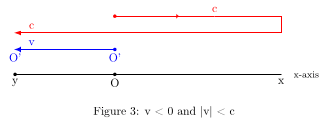On the square root in the Lorentz transformation
Introduction
In the formulas of the Lorentz transformation there is a square root in the ![]() .
.
![]()
![]()
![Rendered by QuickLaTeX.com \[ \gamma = \frac{1}{\sqrt{1-\frac{v^{2}}{c^{2}}}} \]](https://www.hanslugtigheid.nl/wp-content/ql-cache/quicklatex.com-2fc5d82e6b0997f66b2f981842f43fbb_l3.png)
The derivation of the formulas is based on an echo-measurement. A signal with speed c goes forward and at x switches direction and returns with speed c in the opposite direction to meet the origin O’ which moves at speed v along the same axis. We look at the (basic) echo-measurement.
When we derive formula’s we will see that, depending on the relative value of v and c, a square root equal to the one in ![]() appears in the equation. The echo measurement is a minimal and sufficient condition for this square root.
appears in the equation. The echo measurement is a minimal and sufficient condition for this square root.
Echo measurement
We consider two cases:
Case 1: v > 0 and
Case 2: v < 0.
Case 1: v > 0
First we look at v > 0. Wed then have two possibilities: v < c and v > c.
First possibility : v < c.
This is the basis setup of a echo-measurement. See figure 1.

This is the basic situation for an echo-measurement. From the origin O a signal goes with speed c to x and returns to meet O’. O’ moves forward with speed v. The signal and O’ meet in point y.
Second possibility : v > c. See figure 2.

Now v > c. So we see that the signal with speed c and O’ never meet – O’ goes faster than c.
Hence there is no echo-measurement possible. The fact that there is no measurement possible should be reflected in the derived formulas. So there must be a term in the formula that signals that there is no measurement.
So there is a problem when v > c, or c – v < 0. A likely term to show the impossibility of a measurement then is ![]() . The square root of a negative number has no real value. Then the formula ‘protests’ when there is no measurement possible.
. The square root of a negative number has no real value. Then the formula ‘protests’ when there is no measurement possible.
Case 2: v < 0
First possibility : |v| < c see figure 3.

In this case the signal and O’ meet at y. Note that y is left from the original starting point.
Second possibility : c < |v|. See figure 4.

Now |v| > c. So we see that the signal with speed c and O’ never meet – O’ goes faster (to the left) than c.
Again there is no echo-measurement possible. The fact that there is no measurement possible should be reflected in the derived formulas. So there must be a term in the formulas that signals that there is no measurement.
So there is a problem when |v| > c, or – v > c or c + v < 0. A likely term to show the impossibility of a measurement then is ![]() . The square root of a negative number has no real value. Then the formula ‘protests’ when there is no measurement possible.
. The square root of a negative number has no real value. Then the formula ‘protests’ when there is no measurement possible.
Discussion
From the above we see that in a formula for an echo-measurement the formula should result in a non-valid outcome when |v| > c. We have two logical signals: ![]() and
and ![]() .
.
When we combine these signals in a formula we get:
![]()
![]()
![]()
We see that the term
![]()
in the Lorentz transformations
![Rendered by QuickLaTeX.com \[ {\gamma = \frac{1}{ \sqrt{1-\frac{v^{2}}{c^{2}}}}} \]](https://www.hanslugtigheid.nl/wp-content/ql-cache/quicklatex.com-0ad789fecf197b6e60a7f69ac24060e0_l3.png)
comes as a result of the situations that there is no measurement possible. In those cases |v| > c.
In the above it is not necessary that c equals the speed of light.
Hence one has to be cautious to attribute the term in the square root in the ![]() to another reason than that a measurement is not possible.
to another reason than that a measurement is not possible.
In addition consider that the v in the Lorentz transformations is the velocity of the point from which we measure, a point that has no physical dimensions.
Then this is leads to caution in using the ![]() in the Lorentz transformations to conclude that nothing can go faster than the speed of light. There might just not be the possibility of a measurement when |v| > c.
in the Lorentz transformations to conclude that nothing can go faster than the speed of light. There might just not be the possibility of a measurement when |v| > c.